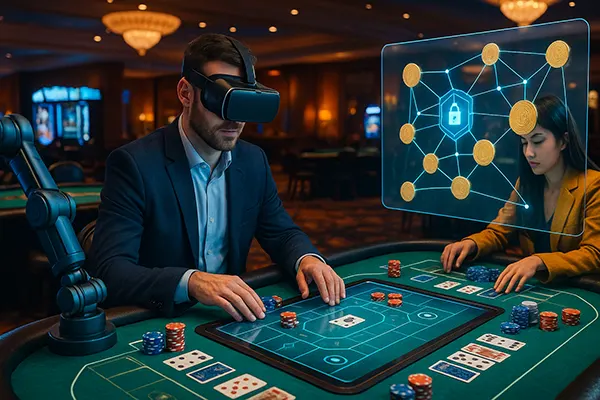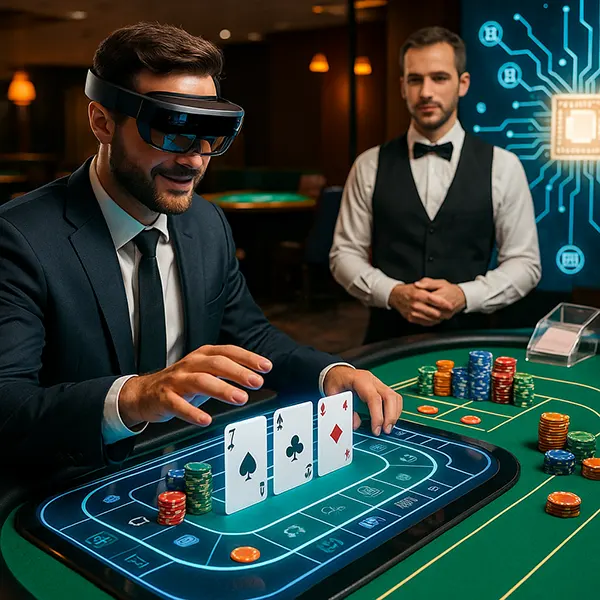
Technological Innovations at the Tables: VR/AR, Smart Tables and Blockchain in Table Games
In 2025, the table gaming industry is experiencing a rapid technological transformation, reshaping how players interact with classic formats. Advanced solutions such as Virtual Reality (VR) and Augmented Reality (AR) are creating immersive virtual gaming halls. Smart tables are enhancing interactivity with touchscreens and automated features, while blockchain technology is reinforcing transparency and introducing unique digital rewards. These innovations are not only redefining user engagement but are also setting new standards for fairness and security in the sector.
Virtual and Augmented Reality in Table Games
VR and AR technologies have become central to the evolution of table games, allowing players to participate in realistic gaming environments without leaving their homes. VR headsets provide a 360-degree view of virtual gaming halls, complete with detailed 3D models of cards, chips, and tables, while AR overlays interactive elements onto the player’s real-world surroundings. This blend of realism and interactivity helps replicate the atmosphere of physical venues with unmatched precision.
Operators are investing in VR-compatible lobbies that allow multiple players to join, interact, and communicate in real-time, adding a social dimension to online table games. The visual fidelity, combined with advanced sound design, creates an authentic experience that bridges the gap between digital and physical play. These spaces are also designed to adapt to various game types, from poker to blackjack, without compromising visual quality.
In addition to entertainment, VR/AR in table games opens possibilities for accessibility. Players with mobility restrictions can join fully simulated environments and interact seamlessly. This inclusive approach, powered by cloud-based rendering and fast data transmission, makes these games available to a wider demographic while maintaining gameplay depth.
Practical Applications of VR/AR for Operators
For operators, integrating VR/AR into table games means more than simply adding visuals. It involves creating secure, optimised systems capable of handling high-resolution graphics and real-time data processing. Modern VR/AR setups also support biometric authentication, ensuring that each player’s identity is verified before joining a session. This added security layer aligns with regulatory standards and player safety measures.
Some developers are experimenting with AR-enabled mobile applications that transform any surface into a playable table. These apps use device cameras and AI tracking to map objects and place interactive gaming elements on them. This allows players to use their dining table, office desk, or coffee table as a game surface, blending leisure with everyday spaces.
The most successful implementations combine hardware compatibility, intuitive interfaces, and responsive design. Ensuring low latency and minimal motion sickness is crucial, making investment in robust servers and optimised code a priority for any VR/AR-enabled gaming environment.
Smart Tables with Interactive Features
Smart tables represent another major leap in table gaming innovation. Equipped with touch-sensitive surfaces, integrated displays, and advanced sensors, these tables enable interactive and automated gameplay. Players can place bets, view game statistics, and access real-time strategy suggestions directly on the table surface without additional devices.
In 2025, many casinos are adopting smart tables with RFID-enabled chips, allowing for instant tracking of wagers and payouts. This reduces the possibility of dealer errors, ensures transparent bet processing, and speeds up game rounds. Players benefit from clear, on-screen information such as win probabilities, historical outcomes, and in-game tutorials.
Smart tables are also being designed with multi-game compatibility, allowing operators to switch between different games with minimal setup time. This adaptability reduces downtime and maximises the efficiency of gaming spaces. For remote play, these tables can be connected to live-streaming systems, enabling hybrid experiences where in-person and online participants share the same game.
Enhancing the Player Experience Through Smart Tables
The latest generation of smart tables incorporates AI-driven personalisation, offering players customised suggestions based on their gameplay history. This includes adaptive difficulty settings, preferred betting ranges, and suggested game variations. Such personalisation improves retention while providing an engaging and tailored experience.
These tables also integrate cashless payment solutions, allowing players to top up balances or withdraw winnings using contactless cards or digital wallets. This not only streamlines the process but also supports hygiene and security in physical venues. Operators can further monitor performance and detect unusual betting patterns for fraud prevention.
Integration with loyalty programmes is another key feature. Players can automatically earn points for each game session, track progress via table displays, and redeem rewards without interrupting gameplay. This seamless connection between the gaming surface and back-end systems creates a unified and efficient gaming ecosystem.

Blockchain Technology and NFT Rewards
Blockchain technology is transforming table games by providing transparent, immutable records of every round played. Using decentralised ledgers ensures that results cannot be tampered with, boosting trust among players and operators alike. This technology also allows for automated smart contracts, handling payouts instantly and without intermediaries.
In 2025, blockchain integration extends beyond fairness. Many developers are leveraging it to issue unique NFT-based rewards to players. These NFTs can represent exclusive digital chips, customised avatars, or limited-edition game skins, all of which can be collected, traded, or sold on blockchain marketplaces. This adds a layer of ownership and personal value to gameplay.
Cross-platform compatibility means that blockchain-verified assets can be used in multiple gaming environments, whether physical or online. This creates an interconnected ecosystem where rewards hold real-world value and player achievements are permanently recorded on the blockchain.
Security and Regulatory Compliance with Blockchain
Blockchain’s cryptographic nature enhances security by protecting player data and financial transactions from unauthorised access. Each transaction is encrypted and stored in multiple nodes, making it extremely difficult to alter or compromise. This is particularly important for maintaining compliance with strict gambling regulations worldwide.
For operators, blockchain solutions offer full audit trails, making it easier to meet transparency requirements set by regulators. This reduces the risk of disputes and strengthens public confidence in gaming operations. Furthermore, blockchain smart contracts ensure that all payout conditions are met automatically, reducing administrative overhead.
The combination of blockchain transparency, NFT integration, and VR/AR experiences represents the cutting edge of table gaming technology in 2025. As adoption continues, these tools are likely to become industry standards, shaping the future of interactive and secure gameplay.
